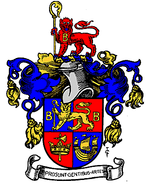Metropolitan Borough of Bermondsey
| Bermondsey | |
|---|---|

Bermondsey Town Hall | |
 Bermondsey within the County of London | |
| Area | |
| • 1911 | 1,500 acres (6.1 km2) |
| • 1931 | 1,503 acres (6.08 km2) |
| • 1961 | 1,504 acres (6.09 km2) |
| Population | |
| • 1911 | 125,903 |
| • 1931 | 111,542 |
| • 1961 | 51,860 |
| Density | |
| • 1911 | 84/acre |
| • 1931 | 74/acre |
| • 1961 | 34/acre |
| History | |
| • Origin | Bermondsey parish Rotherhithe parish St Olave District |
| • Created | 1900 |
| • Abolished | 1965 |
| • Succeeded by | London Borough of Southwark |
| Status | Metropolitan borough |
| Government | Bermondsey Borough Council |
| • HQ | Spa Road |
| • Motto | Prosunt gentibus artes (Arts profit the people) |
 Coat of arms of the borough council | |
The Metropolitan Borough of Bermondsey was a Metropolitan borough in the County of London, created in 1900 by the London Government Act 1899. It was abolished and its area became part of the London Borough of Southwark in 1965.
History
The borough replaced the parish vestries of Bermondsey and Rotherhithe, and the St Olave District Board of Works (consisting of the two parishes of St John Horsleydown and Southwark St Olave and St Thomas).[1]
The Victorian town hall on Spa Road, SE16, was bombed during World War 2. After the war the neighbouring Municipal Offices (1928, designed by H Tansley) took over the role. Bermondsey Town Hall continued to house civic offices, latterly for Southwark Council, until being sold off in 2012.
The population declined sharply after the Second World War, being cut by about half from 1931 to 1951.
Coat of arms
The borough was granted a coat of arms in 1901.[2] The design included references to the three constituent authorities. The lion, crozier and two letters B represent Bermondsey vestry, and are derived from the insignia of Bermondsey Abbey. The crown and axe were the emblem of St Olave's District Board of Works, and were derived from the royal arms of Norway, Saint Olave being the anglicised name of King Olaf II of Norway. The ship represented Rotherhithe and the Surrey Commercial Docks. The symbolism in the coat of arms were incorporated into a sculpture called The Bermondsey Lion that was unveiled in The Blue in 2011.[3]
The Latin motto adopted by the borough was Prosunt gentibus artes or "Arts profit the people",[3] and was adapted from Ovid's Metamorpheses.
Statistics
The area of the Borough was 1,504 acres (6.1 km2). The population from the Census returns was:
St Olave's District Board of Works and Civil Parishes 1801-1899
| Year[4] | 1801 | 1811 | 1821 | 1831 | 1841 | 1851 | 1861 | 1871 | 1881 | 1891 |
|---|---|---|---|---|---|---|---|---|---|---|
| Population | 46,281 | 49,397 | 57,148 | 62,637 | 68,701 | 85,308 | 101,913 | 122,398 | 134,632 | 136,660 |
Metropolitan Borough 1900-1961
| Year[5] | 1901 | 1911 | 1921 | 1931 | 1941 | 1951 | 1961 |
|---|---|---|---|---|---|---|---|
| Population | 130,760 | 125,903 | 119,452 | 111,542 | [6] | 60,638 | 51,860 |
Politics
In the first election to the borough council, held on 1 November 1900 the Moderates (supported by the Conservative party) gained a majority. The opposition group was formed by the Progressive Party. The Moderates retained their majority at the 1903 elections. In 1906 the Moderate group was renamed Municipal Reform. In 1909 The Progressives won 27 seats and the Independent Labour Party 1 to the Municipal Reform's 26 seats, but the latter party retained power through the aldermanic elections. They regained an overall majority of councillors at the 1912 elections.
Local elections were postponed during the First World War, with the next poll held in 1919. The results were a major reverse for the Municipal Reform party with just two councillors elected. The Progressives formed the largest party with 27 seats, followed by the Labour Party with 24. There was one independent councillor. At the 1922 elections Labour gained a majority with 38 seats. The opposition was formed by a Ratepayers Association with 14 councillors. Labour held the council at the subsequent elections, holding all the seats from 1934 to 1945 and from 1949 until the borough's abolition.[7]
References
- ^ F A Youngs, Guide to the local administrative units of England, Volume I, 1979
- ^ Letters Patent dated 25 March 1901
- ^ a b The plaque on the plinth of The Bermondsey Lion in The Blue (September 2012)
- ^ Statistical Abstract for London, 1901 (Vol. IV).
- ^ Bermondsey MetB: Census Tables accessed 14 June 2007
- ^ The census was suspended for World War II
- ^ Election results as reported in The Times, 3 November 1900; 4 November 1903; 3 November 1906; 2 November 1909; 2 November 1912; 4 November 1919; 4 November 1925; 3 November 1928; 4 November 1931; 3 November 1934; 3 November 1937; 2 November 1945; 7 May 1949; 7 May 1953; 11 May 1956; 8 May 1959; 12 May 1962
Further reading
- Robert Donald, ed. (1907). "London: Bermondsey". Municipal Year Book of the United Kingdom for 1907. London: Edward Lloyd.
{{cite book}}: External link in|chapterurl=|chapterurl=ignored (|chapter-url=suggested) (help)

